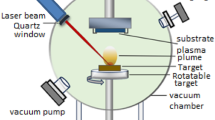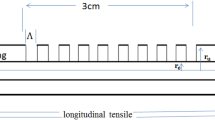Abstract
This article presents an approach to optimize the design parameters of Long period fiber gratings (LPFG) using Jaya optimization algorithm is presented. Long period gratings are passive optical fiber sensors. Transmission spectrum of these gratings contain a number of loss bands at resonance wavelengths. Strength of attenuation peaks at resonant wavelengths and sensitivity of the resonance bands are strong functions of the period of gratings, grating length, peak induced-index change, cladding mode order and fiber composition and core and cladding parameters. We have obtained transmission peak loss of ≈45 dB for 194 µm period, 40 mm length LPFG with peak induced-index change of \( 5 \times 10^{ - 4} \). Ultra high sensitivity of 3000 nm/RIU for liquids and bio-chemicals refractive index range is obtained using the LPFG.
Access provided by Autonomous University of Puebla. Download conference paper PDF
Similar content being viewed by others
Keywords
1 Introduction
Turn around LPFGs have great potential in refractive index sensing. The ultrahigh sensitivity of LPFG that operate at or near turn around point has been reported in literature in a number of applications that include physical parameter sensing [1, 2], chemical sensing [3], adulteration detection [4,5,6], radiation dose [7] etc. True potential of TAP LPFGs can be investigated if we have techniques for optimizing grating and fabrication parameters.
True potential of TAP LPFGs can be investigated if we have techniques for optimizing grating and there are a number of design parameters of LPFGs, and each has its own effects on the sensitivity of these gratings. A systematic review of TAP LPFGs has been given in [8]. Optimization of these parameters therefore can help researchers in fabrication and experimentation of these gratings. This study presents the simple and best possible method to help optimizing the grating parameters. The focus of optimization is to maximize the wavelength shift and the transmission peak in order to facilitate both wavelength and amplitude based demodulations.
Undoubtedly significantly high sensitivities of LPFGs have been reported for physical parameter sensing. Sensitivity enhancement of these gratings for particularly SRI sensing applications such as chemical, biochemical applications, for which it can prove to be boon, is an ongoing research [9,10,11].
In this paper, parameters of long period gratings have been optimized using Jaya algorithm to maximize the sensitivity and transmission loss of these gratings. Section 2 provides the mathematical modeling of LPFGs using weakly guiding regime solved by coupled mode theory. Procedure of Jaya optimization algorithm has been discussed in Sect. 3. Section 4 includes the results obtained by varying the constraints and finally optimized parameters.
2 LPFG Mathematical Model
Coupled mode theory describes the mutual light wave interactions occurring between either counter propagating or co-propagating modes in presence of dielectric perturbation. Ideally, modes do not exchange any energy amongst each other in the absence of perturbation [12, 13].
Fundamental core and cladding modes coupling in LPFG take place in standard optical communication window. Rest coupling may show their effect in transmission or reflection spectrum outside the optical communication window.
Area of overlap of the transverse fields of the resonant modes Ei and average index of the grating \( \Delta n_{i} \), determines that coupling of core and cladding modes
Grating transmission is a function of coupling coefficient \( K \) and is given by
3 Jaya Optimization Algorithm
This algorithm is a meta-heuristic algorithm. Algorithm specific parameters are not required in Jaya algorithm thus making it easy to implement in comparison to well known optimization algorithms. The algorithm has been used in several constrained and unconstrained benchmark problems and other engineering problems [14,15,16]. The expression for variable updation in successive iterations is given as
where \( r_{1} \) and \( r_{2} \) are the random variables in the interval [0,1], i is the no. of iterations, j = 1,2,…,m is the no. of design parameters and k = 1,2,…,n is the no. of candidate solutions. For any iteration i, \( X_{j,best,i} \) provides the best solution out of the candidate solutions and \( X_{j,worst,i} \) provides the worst solution out of the candidate solutions. Flowchart of Jaya algorithm has been shown in Fig. 1.
4 Results
Step index SMF-28 fiber has been considered for optimization using Jaya algorithm. Two layers geometry has been assumed for solving characteristic equation. Table 1 shows the parameters taken for simulation.
Wavelength dependent core and cladding indices have been calculated using Sellmeier equation. Solution to coupled mode theory for first fourteen circularly symmetric cladding modes has been obtained to compute propagation loss at resonance wavelengths.
Maximum number of functional evaluations is set to 5000 as a termination criterion. Simulation has been carried out with population size of 25. Grating parameters - period of grating, grating length, peak induced-index change and SRI have great impact on performance of LPFGs as sensors. Boundary conditions for constraints have been set to restrict the search of optimization algorithm at phase matched turning points being ultrahigh sensitive points.
Linearly polarized higher order modes LP11 to LP14, couple with fundamental mode and yield transmission loss of the order of 45 dB at PMTP ≈ 194, 173, 154 and 139 µm respectively as shown in Fig. 2.
Figure 3 shows the convergence of the optimization function using 5000 function evaluation and 25 population size using Jaya algorithm. Figure 4 shows the phase matching curves for LP11 to LP14 higher order cladding modes Phase Matching curves drawn in figure for higher order cladding modes LP11 to LP14 between grating period and resonance wavelength for standard single mode fiber indicate the presence of turn around points in range \( 125 \le \Lambda \le 145 \), \( 145 \le \Lambda \le 165 \), \( 165 \le \Lambda \le 185 \),\( 185 \le \Lambda \le 205 \) µm.
Grating periods have been varied in these range to obtain maximum transmission loss peaks at phase matched turning around points. Grating length has been varied in \( 10000 \le L \le 40000 \) µm for all simulations. Optimized parameters by considering surrounding refractive index as 1.0 has been given in Table 1.
Dissimilar coupling coefficients result in different loss of attenuation peaks at resonance bands. Fig. 5(a) shows the highest transmission loss of the order of 45 dB is obtained for strong grating with peak induced-index change of \( 5 \times 10^{ - 4} \). Figure 5(b) shows the SRI vs wavelength graph obtained by varying SRI and calculating the resonance wavelength.
Transmission peak loss of 45 dB has been observed after optimizing the parameters of LPFG. It enhances the sensitivity range for amplitude based demodulation. Highly sensitive LPFG with 3000 nm/RIU sensitivity enables LPFGs to be used for wavelength based demodulation schemes.
Surrounding refractive index response of a long-period grating over index range 1.3–1.4 has been modeled. Peak index change of \( 0.5 \times 10^{ - 4} - 10^{ - 4} \) leads to inscription of weak gratings [17]. Strong gratings having peak induced index change of \( 5 \times 10^{ - 4} \) can be inscribed by either enhancing the photosensitivity of fiber or by tuning initial conditions e.g. etching the cladding or coating fiber with high refractive index materials.
5 Conclusion
Optimization of parameters to maximize the sensitivity and transmission loss of long period fiber grating sensors have been reported. SRI sensitivity analysis for higher order cladding modes PMTP LPFGs is accomplished by varying surrounding refractive index in 1.3–1.4 range which corresponds to liquids and most biochemicals. Ultra high sensitivity of 3000 nm per refractive index unit (3000 nm/RIU) has been obtained which is, according to our best knowledge, the highest ever reported in this range. The significance of the proposed work lies in the fact that a lot of work in finding suitable parameters for ultra high sensitivity can be reduced by applying evolutionary optimization algorithms.
References
Bhatia, V.: Applications of long-period gratings to single and multi-parameter sensing. Opt. Express 4(11), 457–466 (1999)
Shu, X., Allsop, T., Gwandu, B., Zhang, L., Bennion, I.: High-temperature sensitivity of long-period gratings in B-Ge codoped fiber. IEEE Photonics Technol. Lett. 13(8), 818–820 (2001)
Hochreiner, H., Cada, M., Wentzell, P.D.: Modeling the response of a long-period fiber grating to ambient refractive index change in chemical sensing applications. J. Lightwave Technol. 26(13), 1986–1992 (2008)
Kher, S., Chaubey, S., Kishore, J., Oak, S.M.: Detection of fuel adulteration with high sensitivity using turnaround point long period fiber gratings in B/Ge doped fibers. IEEE Sens. J. 13(11), 4482–4486 (2013)
Mishra, V., Jain, S.C., Singh, N., Poddar, G.C., Kapur, P.: Fuel adulteration detection using long period fiber grating sensor technology. J. Sci. Ind. Res. (JSIR) 46(2), 106–110 (2008)
Libish, T.M., Linesh, J., Biswas, P., Bandyopadhyay, S., Dasgupta, K., Radhakrishnan, P.: Fiber optic long period grating based sensor for coconut oil adulteration detection. Sens. Transducers 114(3), 102–104 (2010)
Kher, S., Chaubey, S., Kashyap, R., Oak, S.M.: Turnaround-point long-period fiber gratings (TAP-LPGs) as high-radiation-dose sensors. IEEE Photonics Technol. Lett. 24(9), 742–744 (2012)
Gambhir, M., Gupta, S.: Review of turnaround point long period fiber gratings. J. Sens. Technol. 5(04), 81–89 (2015)
Chiavaioli, F., et al.: Towards sensitive label-free immuno sensing by means of turn-around point long period fiber gratings. Biosens. Bioelectron. 60, 305–310 (2014)
Tripathi, S.M., et al.: Long period grating based biosensor for the detection of Escherichia coli bacteria. Biosens. Bioelectron. 35(1), 308–312 (2012)
Gambhir, M., Gupta, S.: Optimization of long period grating at phase matched turning points for bio-chemical sensing. In: 2016 International Conference on Fiber Optics and Photonics, Photonics, pp. W3A-39 (2016)
Ugale, S.P., Mishra, V.: Optimization of reversible LPFG for sensing application. Optik-Int. J. Light Electron. Opt. 125(1), 111–114 (2014)
Oh, K., Paek, U.C.: Silica Optical Fiber Technology for Devices and Components: Design, Fabrication, and International Standards, vol. 240. Wiley, Hoboken (2012)
Rao, R.: Jaya: a simple and new optimization algorithm for solving constrained and unconstrained optimization problems. Int. J. Ind. Eng. Comput. 7(1), 19–34 (2016)
Zhang, Y., Yang, X., Cattani, C., Rao, R.V., Wang, S., Phillips, P.: Tea category identification using a novel fractional Fourier entropy and Jaya algorithm. Entropy 18(3), 77–86 (2016)
Rao, R.V., More, K.C., Taler, J., Ocłoń, P.: Dimensional optimization of a micro-channel heat sink using Jaya algorithm. Appl. Therm. Eng. 103, 572–582 (2016)
Erdogan, T.: Cladding-mode resonances in short-and long-period fiber grating filters. JOSA A 14(8), 1760–1773 (1997)
Author information
Authors and Affiliations
Corresponding author
Editor information
Editors and Affiliations
Rights and permissions
Copyright information
© 2020 Springer Nature Singapore Pte Ltd.
About this paper
Cite this paper
Gambhir, M. (2020). Long Period Fiber Grating Sensors Design Optimization Using Jaya Algorithm. In: Gupta, S., Sarvaiya, J. (eds) Emerging Technology Trends in Electronics, Communication and Networking. ET2ECN 2020. Communications in Computer and Information Science, vol 1214. Springer, Singapore. https://doi.org/10.1007/978-981-15-7219-7_4
Download citation
DOI: https://doi.org/10.1007/978-981-15-7219-7_4
Published:
Publisher Name: Springer, Singapore
Print ISBN: 978-981-15-7218-0
Online ISBN: 978-981-15-7219-7
eBook Packages: Computer ScienceComputer Science (R0)









